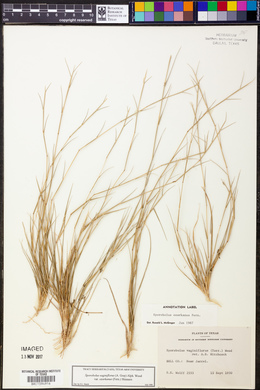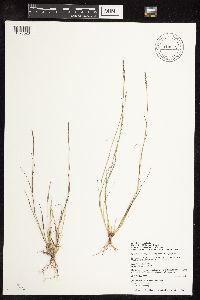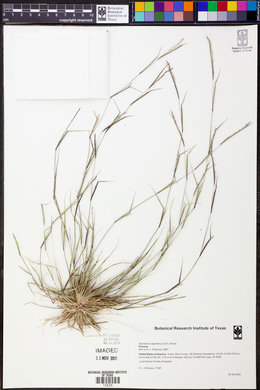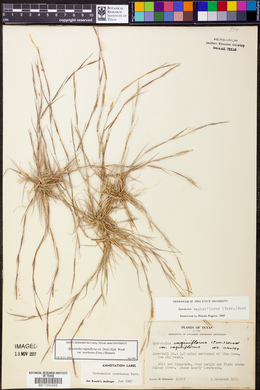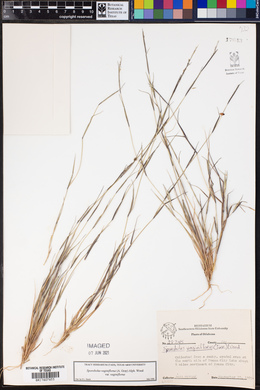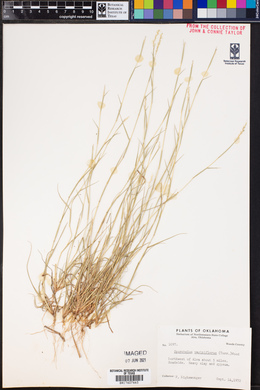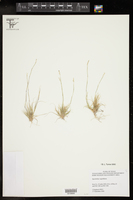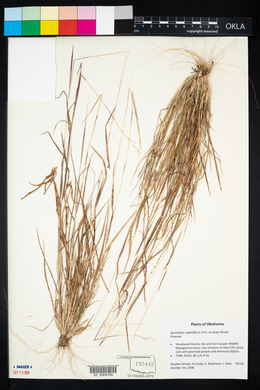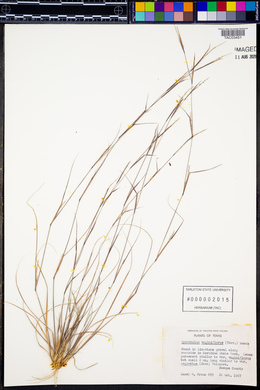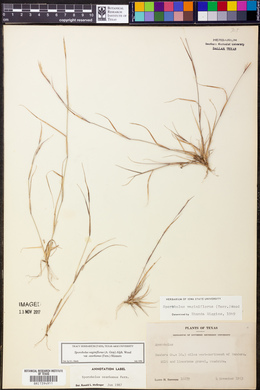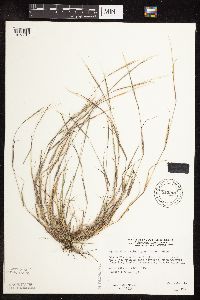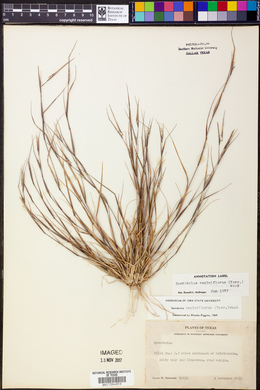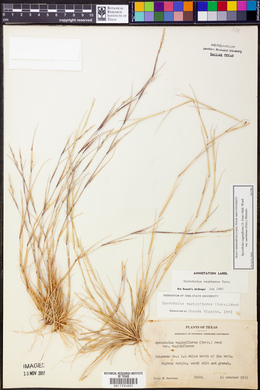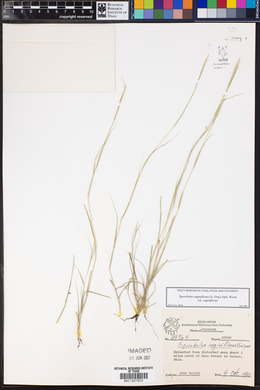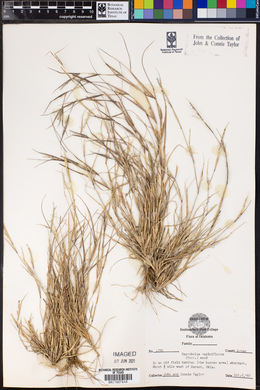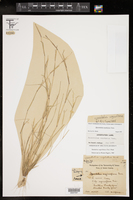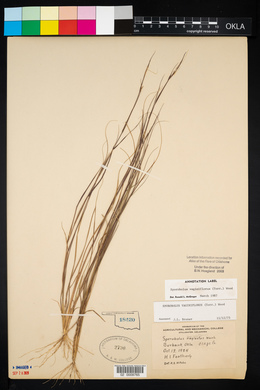Sporobolus vaginiflorus
|
|
|
|
Family: Poaceae
Poverty Dropseed, more...poverty grass, Sporobole Engainé
[Agrostis sporobolus Spreng., moreSporobolus ovatus Beal, Sporobolus vaginatus (Steud.) Scribn., Sporobolus vaginiflorus var. minor Scribn. ex Chapm., Vilfa riehlii Steud., Vilfa vaginiflora] |
Plants annual; tufted, delicate. Culms 15-60(70) cm, erect to decumbent, wiry. Sheaths often inflated, sometimes with sparse hairs basally, hairs papillose-based, glabrous or the apices with small tufts of hairs, hairs to 3 mm; ligules 0.1-0.3 mm; blades 2-12(25) cm long, 0.6-2 mm wide, flat to loosely involute, glabrous abaxially, scabridulous adaxially, bases of both surfaces sometimes with a few papillose-based hairs, margins smooth or scabridulous. Panicles terminal and axillary, 1-5 cm long, 0.2-0.5 cm wide, contracted, cylindrical, enclosed in the uppermost sheath; lower nodes with 1-2(3) branches; primary branches 0.4-1.8 cm, appressed, spikelet-bearing to the base; secondary branches appressed; pedicels 0.2-4 mm, appressed, scabridulous. Spikelets 2.3-6 mm, yellowish to purplish- or grayish-mottled. Glumes subequal, linear-lanceolate to lanceolate-triangular or ovate, membranous to chartaceous, glabrous; lower glumes (2.2)2.8-4.7 mm; upper glumes (2.4)3-5 mm; lemmas (2.1)3-5.4 mm, lanceolate to lanceolate-triangular, 1-3-veined, chartaceous, often mottled with purplish or grayish areas, strigose, hairs less than 0.5 mm, apices acuminate or acute; paleas (2.1)3-6 mm, as long as or longer than the lemmas, sometimes tapering into a beak, lanceolate to lanceolate-triangular, chartaceous, strigose; anthers 3, 1.2-3.2 mm, yellowish or purplish. Fruits (1.1)1.8-2.7 mm, obovoid, laterally flattened, light brownish, translucent. 2n = 54. Sporobolus vaginiflorus is a North American species, native to the eastern portion of the Flora region and probably introduced in the west. It grows in disturbed sites within many plant communities, commonly in sandy to sandy-clay soils, these often derived from calcareous parent materials. Its elevational range is 1-1250 m. Annual tufted herb 15 cm - 0.75 m tall Leaves: having open sheaths that are inflated, sometimes with a few warty-based hairs near the base, otherwise hairless or with small tufts of hairs ( to 3 mm long) at the tip. The ligules are made of hairs 0.1- 0.3 mm long, and the blades are 2 - 25 cm long, 0.6 - 2 mm wide, flat or with margins loosely rolling toward the upper surface of the midvein (involute), smooth or minutely rough along the margins, hairless beneath, minutely rough above, sometimes with a few warty-based hairs near the base. Inflorescence: terminal and axillary, branched (panicle), 1 - 5 cm long, 0.2 - 0.5 cm wide, cylindrical, the base surrounded by the sheath. The apressed primary branches are 0.4 - 1.8 cm long and bear spikelets to the base. Fruit: a transluscent light brownish caryopsis, 1.1 - 2.7 mm long, inversely egg-shaped, flattened laterally. Culm: 15 cm - 0.7 m long, erect to decumbent, thin but stiff, hairless. Spikelets: yellowish to mottled with purple or gray, 2.3 - 6 mm long, borne on a stalk that is appressed, minutely rough, and 0.2 - 4 mm long. Glumes: nearly equal, narrow lance-shaped to lance-triangular or egg-shaped, membranous to thin but firm (chartaceous), hairless. The lower glume is 2.2 - 4.7 mm long, and the upper glume is 2.4 - 5 mm long. Florets: usually one per spikelet, with three yellowish to purplish anthers 1.2 - 3.2 mm long. Lemma: usually mottled with purple or gray, 2.1 - 5.4 mm long, lance-shaped to lance-triangular or egg-shaped with a pointed tip, one- to three-veined, thin but firm (chartaceous), longitudinally lined, with hairs shorter than 0.5 mm long. Palea: 2.1- 6 mm long, lance-shaped to lance-triangular, occasionally tapering to a beak, thin but firm (chartaceous), longitudinally lined, hairless, and two-veined, often splitting between the veins when mature. Similar species: Sporobolus neglectus has sheaths that are hairless near the base and shorter spikelets (1.6 - 3 mm), but lacks longitudinal lines on its lemmas. The other species of Sporobolus in the Chicago Region are perennials lacking inflated sheaths. Flowering: early August to mid September Habitat and ecology: Frequent in waste ground and along railroads, common along crushed limestone roads, abundant in compacted soils of road shoulders and parking lots, and occasional in prairies. Occurence in the Chicago region: native Etymology: Sporobolus comes from the Greek words sporos, meaning seed, and ballein, meaning "to cast forth." Vaginiflorus means "with flowers in sheaths." Author: The Morton Arboretum |
|
|
|

















